VW T3 workshop repair manual
Following the T2, the sort 2, T3 - Transporter 2 Generation 3 - initially showcased air-cooled and afterwards water-cooled motors.
Volkswagen marketed the Westfalia camper variant through the T3 manufacturing, with features including a pop-up roofing, ice box, sink, and kitchen
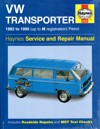
Get Other VW Transporter Repair Manuals click here VW Volkswagen Transporter (water-cooled) Petrol 1982 - 1990 Haynes Owners Service Repair Manual covers: Van Pickup and Minibus (Caravelle) with water-cooled engines. Engines Covered: - 1.9 litre (1913cc) (DF DG EY GW) - 2.1 litre (2109cc) (DJ MV SS codes) four cylinder models. Contents: - Routine Maintenance - Tune-Up Procedures - Engine Repair - Cooling And Heating - Air-Conditioning - Fuel And Exhaust - Emissions Control - Ignition Brakes - Suspension And Steering - Electrical Systems - Wiring Diagrams NOTE: Only maintenance adjustment minor repair procedures plus removal and installation are described for the Transmissions.
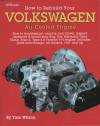
Rebuild Aircooled VW Engines HP255 by Tom WilsonGet other VW repair manuals hereA guide to engine rebuilding includes discussions of removal parts indentification cylinder head reconditioning and engine assembly Integracar tries to make available a diverse array of workshop guides. But owners manuals can be created for assorted countries and the motor cars engineered for those nations. That means not all service manuals may be acceptable for your particular car. If you have queries whether a particular repair manual is relevant for your automobile kindly contact us hereRebuild Aircooled VW Engines HP255 by Tom Wilson
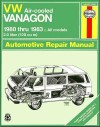
Volkswagen (VW) Vanagon 1980 - 1983 Haynes Owners Service Repair Manual covers 1980-1983 Volkswagen (VW) Vanagon with 2.0 litre air-cooled flat-four engines.Note: this manual DOES NOT cover water-cooled or diesel engine models.Contents: Introduction: Vehicle Identification Numbers. Buying Parts. Safety. Maintenance Techniques. Chemical And Lubricants And More. Tune-Up And Routine Maintenance General Engine Overhaul Procedures Cooling Heating And Air-Conditioning Systems Fuel And Exhaust Systems Engine Electrical Systems Emissions Control Systems Transmission Driveline Brakes Suspension And Steering Systems Body Chassis Electrical System Wiring Diagrams
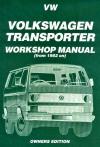
Volkswagen VW Transporter 1982 - 1989 Owners Workshop Manual Covers The following Engine Reference Letters: Carburetor 1.9 Litre - DF DG or EY. Injected 1.9 Litre - GW. 2.1 Litre Without Catalytic Converter - DJ. 2.1 Litre with Catalytic Converter - MV.Covers the Water Cooled Rear-Engined Petrol models only with Manual Gearbox from 1982 - 1989. Kombi. Stationwagon. Bus. Camper. Caravelle. Pick-Up 1.9 Litre and 2.1 Litre Carburettor Fuel Injected Water Cooled Engines.Contents:: Engines Ignition System Lubrication System Cooling System Carburettor Fuel System Fuel Injection System Exhaust System Clutch Manual Transmission Automatic Transmission Rear Drive Shafts Rear Axle Transmission Front Suspension Mechanical Power Assisted
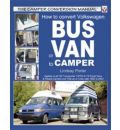
How to Convert Volkswagen Bus or Van to Camper by Lindsay PorterGet other VW repair manuals hereThis volume contains detailed step-by-step instructions for converting a VW Transporter van or bus to a Camper. It gives advice on how to choose the best van for your needs and prepare it - how to plan the layout and choose fittings how to fit an elevating roof how to cut panels and fit utilities. Integracar tries to have a sizeable array of owners guides. However owners manuals can sometimes be manufactured for very different nations and the motor vehicles designed for those nations. For this reason not all workshop manuals may be applicable for your individual car. If you have important questions whether or not a selected maintenance manual is best suited for your car do not hesitate to make contact with us hereHow to Convert Volkswagen Bus or Van to Camper by Lindsay Porter
Volkswagen marketed the Westfalia camper variant through the T3 manufacturing, with features including a pop-up roofing, ice box, sink, and kitchen stove.
1991 Volkswagen Transporter 2-door utility
Examples built between 1980 and 1985 showcased round headlights and chrome-plated metal bumpers with plastic end-caps. Air-cooled brands are lacking the low barbeque grill above the radiator for the water-cooled products, except on products with factory air conditioning. 1986 design seasons automobiles got changes including a tachometer, additional textile options, redesigned air conditioning unit, larger water-cooled system with a far more advanced level engine management system, and redesigned transmissions like an optional Syncro four-wheel drive. Outside adjustment add rectangular headlights and differing paint choices. Alloy wheels, larger and squarer vinyl bumpers with trim across the rocker panels had been recommended, and standard products on Wolfsburg version vans. For 1990 and 1991 model ages, a "Carat" trim amount was readily available including all available alternatives.
All 1980 and some 1981 products have eight welded-in steel slats covering the motor ventilation passages behind the trunk microsoft windows. Later on models had black colored vinyl 16-slat covers that slotted in at the very top and screwed straight down at the bottom.
During the 1980s, the U.S. Army and Air Force in Germany put T3's as administrative motors. In military utilize the car's nomenclature was "lighter Truck, Commercial".
Porsche has created a variation known as B32 in a limited edition. The van, on the basis of the luxurious Carat model, is designed with the 231 PS 3.2 liter Carrera engine and is initially created to support Porsche's screening tasks in Algeria. Ten among these had been built, with some offered by Porsche to unique subscribers. Porsche by themselves additionally used the Porsche-engined bus to move workforce rapidly. Top rate is around 135 mph, although Porsche just advertised 116 mph to ensure the data could possibly be replicated with nine group within the vehicle and with the air-conditioning on full blast.
Oettinger is promoting a six-cylinder variation called WBX6. The system comes from the "Wasserboxer" motor and has now many typical section along with it. The development of the system ended up being originally contracted to Oettinger by VW. Oettinger bought the rights when VW decided not to use it.
Almost all of the characteristics of this RR setup become shared with the mid-engine, or MR. Placing the engine nearby the driven back tires allows for an actually modest, light, less complex, plus efficient drivetrain, because there is no dependence on a driveshaft, in addition to differential may be incorporated aided by the transmission, commonly referred to as a transaxle.
Considering that the motor is typically the heaviest element of the automobile, putting it near the backside axle frequently results in more excess body fat on the back axle than the front side, commonly named a back pounds prejudice. The farther straight back the motor, the higher the bias. Typical fat bias for an FR, try 55/45 front/rear; for MR, 45/55; for RR, 35/65. Back body weight bias reduces forward fat transfer under braking, and increases rear pounds transfer under acceleration. The former means that grip is much more uniformly delivered among all four tires under braking, resulting in smaller blocking circumstances and distances. The second implies that the driven rims has enhanced grip when accelerating, letting them put even more power on the floor and speed up faster.
The disadvantage to a rear pounds prejudice is that the vehicles may become unstable and often oversteer whenever decelerating. In turns, this tendency is much more obvious, to the point that even letting off the throttle slightly while switching could cause a corner tires to unexpectedly drop grip, in addition to automobile to slip rear-first. When this happens, rotational inertia dictates the added pounds away from the axis of rotation may well be more very likely to retain the spin, specifically under stopping. This can be an inherent instability in the build, making it simpler to trigger and more hard to recover from a slide compared to a less rear-weight-biased vehicle. All vehicles, irrespective of drivetrain layout, obey the exact same legislation of physics and will do this, however it is less difficult doing and harder to correct in MR and RR motors.
If not braking, the diminished pounds over the front rims means less traction, leading to the automobile creating a propensity to understeer, that will be safer and much more steady it is unwanted in cornering. To counteract this, it's important to cause forward pounds transfer to improve forward hold, but this substantially destabilizes the vehicle and may feel hard to do precisely, this is certainly, without rotating. High-performance driving necessitates inducing body weight transfer, no matter drivetrain layout, but it is most important in MR and especially RR designs, and the greater impact from it is more hard to deal with.
During these areas, an RR can be viewed to be an exaggeration of MR - more difficult braking, faster and earlier speed, and increased oversteer, but faster switching if it could be managed.
In off road and low-traction circumstances, the RR layout has many benefits versus more 2WD layouts. The weight is biased to the driven tires- much like FF motors. This both improves drive-wheel traction and lowers the tendency for the undriven tires to dig in. Additionally, the driving and steering specifications are separate between front and rear- much like FR cars- rendering it not as likely for either to reduce traction. Numerous dune buggies effectively need a Volkswagen beetle since the donor vehicle that is why. The general simpleness and light-weight compared to 4WD can so sometimes exceed the downside of best having two driven wheels.
Where RR varies from MR is within the motor is based outside the wheelbase. The most important advantageous asset of MR - lowest minute of inertia - try negated significantly, and there is most area for passengers and cargo. Furthermore, because both axles are on the same region of the engine, it is technically simpler to push all wheels, compared to a mid-engined configuration. Eventually, a rear-mounted motor possess empty atmosphere behind they whenever going, enabling more cost-effective air conditioning for air-cooled vehicles.
For liquid-cooled cars, but this design presents a drawback, as it requires either increased coolant piping from a front-mounted radiator, or moving the radiator toward side or rear, and including air ducting to compensate for reduced airflow guiding the car.
As a result of the maneuvering difficulty, the necessity for most room performance, and near common usage of liquid-cooled engines in modern vehicles, more producers need abandoned the RR layout. The major exclusion was Porsche, who has created the 911 for more than 40 years and contains cheated the many benefits of RR while mitigating its disadvantages to acceptable amount, lately by using electric helps.
The Volkswagen Type 2 ended up being the next generation associated with the Volkswagen Transporter and had been promoted under various nameplates global â including since the Transporter or Caravelle in European countries, Microbus in South Africa, and also as the Vanagon in North and south usa.
Larger and weightier than its predecessor, the T2, â and with an even more squared much less curved styling â the T3 ended up being manufactured in Germany from 1979 until 1990. Production of the 2WD proceeded until 1992 at Puch in Graz/Austria, in which all 4WDs was in fact built. South African creation of the T3 carried on, for that marketplace best, until 2002. The T3 was the final generation of rear-engined Volkswagens.
Properties
With the internal-combustion system and transaxle installed suprisingly low inside straight back, the T3 have much bigger disc brake system right in front, and drums within the backside. Axle fat is quite almost equal upon the front side and back stops of vehicle. Unlike the T2 before they, the T3 ended up being offered with facilities including power steering, air conditioning, energy home hair, electrically controlled and heated mirrors, lighted vanity mirrors, and a light above the glove package.
The automatic had been a regular hydraulic three-speed device, the same 090/010 device as utilized in Audis for the age. These featured a cast aluminum alloy case the transmission section, and a cast metal circumstances the best drive section.
The 091 handbook transmission had been a four-speed product, featuring a lightweight aluminium alloy situation; from 1983 a 5-speed transmission had been offered as a choice on specific versions; a 5-speed was installed as traditional on diesels and Syncro four-wheel drive models.
The automated services a 1.0 proportion top gear, as the handbook features a 0.85 top gear.
The oil filler pipe for the engine is based behind the flip-down permit dish home, as is the oils dipstick plus the energy steering fluid reservoir. Many vans have a twist-on/off gasoline limit directly on the surface slightly below and behind the passenger side-door. A locking limit had been optional. The free tyre is based on a tray underneath the extremely front regarding the van, just below the radiator.
Engines
Due to the motor positioning, a T3 possess almost equal 50/50 body weight circulation fore and aft. The first air-cooled motors are significantly high priced to create and had some dependability problems. Volkswagen originally designed to exchange these with the Golf's inline-four motor but the price of re manufacturing both car and system made all of them go for updating the flat-four rather. An overhead-cam design had been mooted but rejected as readiness to rev ended up being regarded as being of less benefit than low-end freedom and low-cost. The brand new 1.9 "Wasserboxer" has also been originally considered for usage using various other Volkswagens for instance the Gol, which nonetheless relied regarding the older air-cooled flat-four at that time.
The U.S version 1.9 liter 1984 additionally the subsequent 1985 or over water-cooled fuel motors experienced significant and recurring problems with cylinder mind surface erosion and coolant leaks. 2.1lr engines experienced exactly the same, mainly considering without having the antifreeze changed often sufficient.
Petrol/gasoline
There have been four general petrol motor variations between 1979 and 1991, with several sub-models. All are overhead-valve push-rod horizontally opposed four-cylinder motors. Available system choices differed between regions. Aftermarket VW specialist Oettinger additionally offered the WBX6, a six-cylinder version.
Air-cooled
1.6 L air-cooled, solitary Solex 34 PICT-4 carburettor
2.0 L air-cooled, twin Solex 34 PDSIT-2/3 carburettor or gasoline injected flat-four in 1980 to 1983½ brands
Water-cooled
1.9 litre motors:
1.9 L water-cooled motor employed for the 1983½ to 1985 products, that used a gasoline injection system generally "Digijet"
1.9 L 8.6:1 compression ratio, 34-PICT carburetor
1.9 L 8.6:1 compression ratio, 2E3 or 2E4 carburetor
1.9 L 7.5:1 compression proportion, 34-PICT carburetor
1.9 L 8.6:1 compression ratio, Bosch Digijet electronic fuel injection
2.1 Litre engines:
2.1 L Wasserboxer, utilized through to the end of Vanagon importation into the US in 1991. This engine used a far more advanced level engine administration system called Bosch "Digifant I" which today digitally was able ignition time plus fuel shipments.
2.1 L 9:1 compression ratio Wasserboxer
2.1 L 10:1 compression proportion, Digijet shot, only marketed in countries in europe not calling for catalytic converter.
The Wasserboxer featured an aluminum instance, cylinder minds, and pistons, and a forged metal crankshaft. The Wasserboxer, as with every VW boxer engines have a gear-driven camshaft. Moreover it featured Heron, or "bowl-in-piston" kind combustion chambers in which the combustion occurs within the piston dish region, and not simply into the cylinder mind as is the circumstances with flat-top pistons..
The switch to water-cooled boxer engines was made mid-year in 1983. T2 transporters or 'bay window' vans, stated in Brazil until 2013, were switched to in-line 4 cylinder water-cooled machines and a front mounted radiator in 2005.
Production of the T3 continuing in Southern Africa until June 2002, when, due to the economies of scale, Volkswagen SA were obliged to cease manufacturing after components supply began to be a problem. The South African T3s article 1991 have a face-lift including altered door piece steel, larger part house windows behind the B pillars and differing rear grilles into the D pillars. The bodyshell was a true RHD design lacking the unused home track cover from the offside and LHD wiper arm mount points as available on previous brands. On versions with 5-cylinder engines the boot flooring was raised to support the bigger motor and has little storing places either region of the system hatch. Interior modifications add a totally cushioned dashboard featuring a smaller glove package and updated vacuum-powered air flow controls managed by circular knobs instead of slip levers, the fuse box was also relocated off to the right hand side of the steering column. At the front end for the car twin-headlamps in both round and rectangular configurations were installed alongside a full width reduced grille incorporating the indicator lenses, which were altered from amber to smoked contacts from 1999 onwards, this grille and headlight blend was not receive any place else worldwide. These later on South African T3s became known as Big Window T3s for their bigger side microsoft windows.
The 2.1 Wasserboxer engines had been replaced with five-cylinder Audi engines inside "Microbus" and "Caravelle", while a VW 1.8 inline-four cylinder engine was used in the "Kombi" and "Van" products. The 5-cylinder T3's arrived in the beginning with a 2.5 litre gas inserted motor in 1991, but this was replaced in 1995 with a 2.6 litre with a greater gas shot program, 5-speed transmission as well as 2 varieties of 15" alloy rims as traditional alongside larger ventilated front disc brakes. A somewhat reduced spec 2.3 five cylinder fuel-injected design ended up being introduced combined with 2.6 but ended up being built with a 4-speed transmission and altered wrap-around metal bumpers. Near the end of manufacturing, a high of the range Caravelle 2.6i known as the "Exclusiv" incorporated two rear-facing chairs instead of the centre bench seat, a fridge and a folding table at the back of the vehicle and Carat 2 alloy wheels. A Microbus 2.6i with similar properties, but with Rhein alloy tires ended up being referred to as "Activ". The last T3 from the production line in Uitenhage on Friday Summer 16, 2002 had been a gold-coloured Microbus 2.6i which Volkswagen SA retained with their AutoPavilion, host to vehicles and Legends, which initially exposed their doorways in 2004. The car is later on written down in a transporter roll-over crash in November 2006, after going back from a display in Cape city.
Is there a parts interchange guide anywhere on the internet? Plus, I'm looking for a chart or guide that will tell me what model car/year has what engine/tranny (not sizes or drive types, but code designations) I have a 96 golf, 4dr. Nothing special, but I'd like to know what it has, what...
Made this thread to reduce the threads and questions that are "where is this or that". Just look here and you will know. 1. Mass Airflow sensor 2. EVAP canister 3. Fuel pressure regulator 4. Positive crankcase ventilation valve (PCV valve) 5. Intake air temperature sensor 6. Throttle position...
That's definitely a strange issue — the RCD clock showing 00:00 or random times like 6:28, while your instrument cluster shows the correct time, suggests a communication or memory problem within the infotainment unit. Let’s break it down and go through the common causes and solutions for your 2016 Jetta with an RCD unit: 🧠 What Could Be Causing This? 1. RCD Unit Not Syncing with CAN Bus ...
That heart-stopping moment when the brake light suddenly glows bright red on your dashboard—I've been there! Last winter, it happened to me during a rainstorm, and I nearly panicked until a mechanic discovered my brake fluid was running low due to a tiny leak I never would have spotted myself...
So here is a cooling system and engine temperature issue thread. Read this before posting on your over heating car and such. I will also outline the commonly failing thermostat. So here's the issues: Overheating: -Check that your fans are cycling (If not check your fuse in position 19 for your...
1. VW Type 1 Engines (Beetle, Karmann Ghia, Thing, Type 2 Bus) These engines were flat-four, air-cooled, rear-mounted, and used in many VW models. Engine Code Displacement Fuel System Power (HP) Applications 25 hp (No Code) 1131cc Carbureted 25 hp Early Beetles (1945–1953) 30 hp (No Code)...
Try crankshaft position sensor. Mine did the exact same crap... then finally would start after I screwed with it for hours and hours and hours... it'd hit running temp... more like struggle to hit running temp... and die. and would then again crank but no start for ever... until it cooled down... and I jumped this or that, so on n so forth. Popped in a new sensor... and everything was peachy ...
VW Polo - This is the discussion forum for the VW Polo (VW Polo Forum, Volkswagen Polo Forum, Volkswagen Polo)
This discussion area is for any general discussions related specifically to Volkswagen.
Very long story short we have a Tiguan we’ve had in the dealer numerous times. The low oil light comes on every time before the car makes it to 10k mile oil changes. Roughly around 6k-7k. The dealer has done a consumption test. Checked for leaks. Etc. Just picked it back up today and they topped...